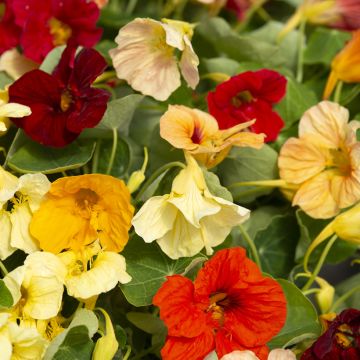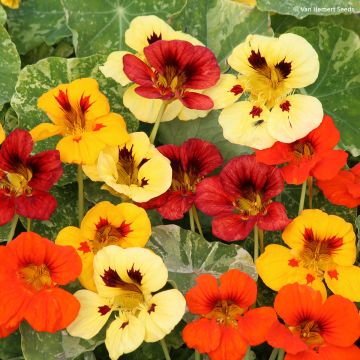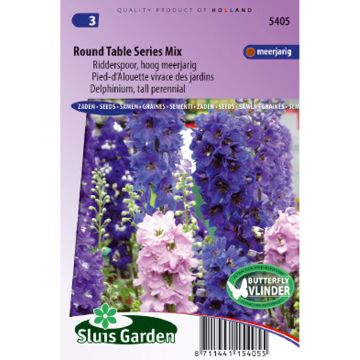

Tropaeolum majus Peach Melba Superior Seeds - Nasturnium
Tropaeolum majus Peach Melba Superior Seeds - Nasturnium
Tropaeolum majus nanum Melba Superior
Nasturtium, Garden nasturtium,Indian cress, Monks cress
Special offer!
Receive a €20 voucher for any order over €90 (excluding delivery costs, credit notes, and plastic-free options)!
1- Add your favorite plants to your cart.
2- Once you have reached €90, confirm your order (you can even choose the delivery date!).
3- As soon as your order is shipped, you will receive an email containing your voucher code, valid for 3 months (90 days).
Your voucher is unique and can only be used once, for any order with a minimum value of €20, excluding delivery costs.
Can be combined with other current offers, non-divisible and non-refundable.
Home or relay delivery (depending on size and destination)
Schedule delivery date,
and select date in basket
This plant carries a 6 months recovery warranty
More information
We guarantee the quality of our plants for a full growing cycle, and will replace at our expense any plant that fails to recover under normal climatic and planting conditions.
Would this plant suit my garden?
Set up your Plantfit profile →
Description
The 'Peach Melba Superior' Organic Dwarf Nasturtium, scientifically known as Tropaeolum majus, is an annual plant with large cream-yellow flowers highlighted by a throat speckled with peach to reddish-orange. They bloom from July to October above a decorative, round, dark blue-green foliage that enhances the flowering. Plant it in borders, pots, or hanging baskets, where its stems will trail. Edible and organic, add its leaves and flowers to salads and enjoy their spicy flavour.
Nasturtium belongs to the Tropaeolaceae family. It is native to South America and is sometimes called Peruvian Cress. It is a climbing or creeping annual plant. It has given rise to numerous varieties and forms, which are more or less compact, with single or double flowers. 'Peach Melba Superior' Organic Dwarf Nasturtium is a dwarf hybrid, but vigorous, reaching a width of 40 cm and a height of 30 cm. The plant forms a beautiful mound of foliage and blooms from July to October, producing numerous 5 to 6 cm trumpet-shaped flowers that stand out well from the foliage. Their petals are unequal with a spur, cream-yellow with small touches of peach to reddish-orange in the throat. In our climates, it is mainly bumblebees that pollinate this plant. The flowering is followed by fruits containing seeds slightly smaller than peas, which are easy to sow. The foliage consists of round, peltate leaves, about 4 cm wide, of an elegant blue-green.
The 'Peach Melba Superior' Nasturtium prefers a warm and sunny exposure to flower well, but it can tolerate light shade. The size of its seed and its low requirements make it a suitable plant for beginner gardeners and children. On balconies, the 'Peach Melba Superior' Organic Dwarf Nasturtium generously fills pots, planters, and containers. It blends perfectly with trailing annuals such as petunias, geraniums and verbenas. Planted at the front of flower beds, it takes up space and acts as a ground cover, smothering weeds.
The leaves and flowers of Nasturtium are edible and add a slightly spicy flavour and vibrant colours to salads. When picked while still green, the large seeds, the size of a chickpea, can be pickled in vinegar.
Flowering
Foliage
Plant habit
Botanical data
Tropaeolum
majus nanum
Melba Superior
Tropaeolaceae
Nasturtium, Garden nasturtium,Indian cress, Monks cress
Cultivar or hybrid
Other Nasturtium seeds
View all →Planting and care
Two ways of sowing Peach Melba Superior nasturtium:
Sow in pots under shelter in March-April, in groups of 3 to 5 seeds. Place your pots in a bright room at a minimum of 18°C. It takes about 18 days for the seedlings to appear. Transplant your seedlings to the garden in May, after the last frost. Space your plantings at least 50 cm apart.
Sow your Nasturtiums directly in the garden from May (when the frost has passed) to June, in groups of 3 to 5 seeds.
Water abundantly during cultivation. Removing faded flowers will encourage new flowering. Nasturtiums are a real treat for aphids and caterpillars (especially those of the Cabbage White butterfly). The advantage is that they prevent an invasion on your cabbages. Therefore, do not place them near your cabbages in your vegetable garden.
Sowing period
Intended location
Planting & care advice
This item has not been reviewed yet - be the first to leave a review about it.
Similar products
Haven't found what you were looking for?
Hardiness is the lowest winter temperature a plant can endure without suffering serious damage or even dying. However, hardiness is affected by location (a sheltered area, such as a patio), protection (winter cover) and soil type (hardiness is improved by well-drained soil).

Photo Sharing Terms & Conditions
In order to encourage gardeners to interact and share their experiences, Promesse de fleurs offers various media enabling content to be uploaded onto its Site - in particular via the ‘Photo sharing’ module.
The User agrees to refrain from:
- Posting any content that is illegal, prejudicial, insulting, racist, inciteful to hatred, revisionist, contrary to public decency, that infringes on privacy or on the privacy rights of third parties, in particular the publicity rights of persons and goods, intellectual property rights, or the right to privacy.
- Submitting content on behalf of a third party;
- Impersonate the identity of a third party and/or publish any personal information about a third party;
In general, the User undertakes to refrain from any unethical behaviour.
All Content (in particular text, comments, files, images, photos, videos, creative works, etc.), which may be subject to property or intellectual property rights, image or other private rights, shall remain the property of the User, subject to the limited rights granted by the terms of the licence granted by Promesse de fleurs as stated below. Users are at liberty to publish or not to publish such Content on the Site, notably via the ‘Photo Sharing’ facility, and accept that this Content shall be made public and freely accessible, notably on the Internet.
Users further acknowledge, undertake to have ,and guarantee that they hold all necessary rights and permissions to publish such material on the Site, in particular with regard to the legislation in force pertaining to any privacy, property, intellectual property, image, or contractual rights, or rights of any other nature. By publishing such Content on the Site, Users acknowledge accepting full liability as publishers of the Content within the meaning of the law, and grant Promesse de fleurs, free of charge, an inclusive, worldwide licence for the said Content for the entire duration of its publication, including all reproduction, representation, up/downloading, displaying, performing, transmission, and storage rights.
Users also grant permission for their name to be linked to the Content and accept that this link may not always be made available.
By engaging in posting material, Users consent to their Content becoming automatically accessible on the Internet, in particular on other sites and/or blogs and/or web pages of the Promesse de fleurs site, including in particular social pages and the Promesse de fleurs catalogue.
Users may secure the removal of entrusted content free of charge by issuing a simple request via our contact form.
The flowering period indicated on our website applies to countries and regions located in USDA zone 8 (France, the United Kingdom, Ireland, the Netherlands, etc.)
It will vary according to where you live:
- In zones 9 to 10 (Italy, Spain, Greece, etc.), flowering will occur about 2 to 4 weeks earlier.
- In zones 6 to 7 (Germany, Poland, Slovenia, and lower mountainous regions), flowering will be delayed by 2 to 3 weeks.
- In zone 5 (Central Europe, Scandinavia), blooming will be delayed by 3 to 5 weeks.
In temperate climates, pruning of spring-flowering shrubs (forsythia, spireas, etc.) should be done just after flowering.
Pruning of summer-flowering shrubs (Indian Lilac, Perovskia, etc.) can be done in winter or spring.
In cold regions as well as with frost-sensitive plants, avoid pruning too early when severe frosts may still occur.
The planting period indicated on our website applies to countries and regions located in USDA zone 8 (France, United Kingdom, Ireland, Netherlands).
It will vary according to where you live:
- In Mediterranean zones (Marseille, Madrid, Milan, etc.), autumn and winter are the best planting periods.
- In continental zones (Strasbourg, Munich, Vienna, etc.), delay planting by 2 to 3 weeks in spring and bring it forward by 2 to 4 weeks in autumn.
- In mountainous regions (the Alps, Pyrenees, Carpathians, etc.), it is best to plant in late spring (May-June) or late summer (August-September).
The harvesting period indicated on our website applies to countries and regions in USDA zone 8 (France, England, Ireland, the Netherlands).
In colder areas (Scandinavia, Poland, Austria...) fruit and vegetable harvests are likely to be delayed by 3-4 weeks.
In warmer areas (Italy, Spain, Greece, etc.), harvesting will probably take place earlier, depending on weather conditions.
The sowing periods indicated on our website apply to countries and regions within USDA Zone 8 (France, UK, Ireland, Netherlands).
In colder areas (Scandinavia, Poland, Austria...), delay any outdoor sowing by 3-4 weeks, or sow under glass.
In warmer climes (Italy, Spain, Greece, etc.), bring outdoor sowing forward by a few weeks.



























































